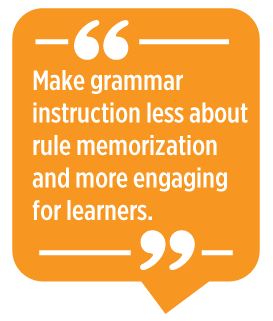
Teachers of English to speakers of other languages often focus on grammar because it is associated with the mastery of the rules of a language (Larsen-Freeman, 2015). This emphasis on rules, which entails rote memorization with little or no communicative practice, is due to a number of factors, including teachers’ training, the structure of national curriculum, and standardized testing in some contexts where learners are given mechanical exercises or asked to produce/write random sentences. Though paying attention to language forms is important, it is not sufficient for effective communication (Celce-Murcia, 2007). The teaching and learning of grammar needs to be connected to the communicative use of the target language (Spada, 2007), which remains the ultimate goal of language learning.
In this article, I discuss how teachers can make grammar instruction less about rule memorization and more engaging for learners. I explain how teachers can create opportunities for meaningful interactions in the target language via real or imagined situations that are similar to learners’ real life experiences.
Building on Situations
Building on situations simply implies teaching grammatical features in context instead of presenting them as abstract concepts, which “deny learners the opportunity of seeing the systematic relationships that exist between form, meaning, and use” (Nunan, 1998, p. 102).

Proponents of the situational approach posit that language needs context because context breeds meaning, and one way to illustrate meaning is via a situation (Riddell, 2014). Simply put, this approach recommends introducing all language structures via real or imagined situations, with the situations providing context for the grammatical features. Wajnryb (1990) posits that “context gives a more precise understanding of how to use grammar [features]” (p. 6) because it:
-
presents the features in an authentic manner—a real communication context;
-
helps learners to establish a correlation between context, meaning, and usage of a language feature; and
-
enables learners to associate meaning with linguistic forms clearly, which makes it easier for them to use outside the classroom as they are able to relate the classroom situations in which language features are employed and their real life experiences.
In as much as decontextualized grammar teaching/learning may help learners to assimilate, memorize, and perhaps know rules explicitly, it will not lead to spontaneous use when communicating (Mart, 2013). Given that the goal of language learning is to develop communicative competence in a target language, teaching and learning a language need to be done via situations that are connected to real life.
Exploring the Situational Approach in the Teaching of Grammar
There are three main stages to be explored when teaching grammar via the situational approach. Proceed by laying emphasis on meaning first, then form and use, and finally practice.
1. Meaning
Meaning construction is at the core of language teaching and learning because it is the purpose of using language. Meaning is constructed via a context. Consequently, building context for teaching language features becomes an important step in helping learners to understand the meaning and usage of features and eventually using them correctly in spontaneous speech. It is important to build context slowly, guide learners through the process, and keep them involved throughout. One way of ensuring this is to elicit, as much as possible, from learners—not tell them what they can say by themselves. Teachers can build context by using different techniques, including the following:
-
The pictorial technique: This technique entails using visuals, such as pictures, videos, or real objects, to present language forms in context. For example, you plan to teach the present continuous tense, so you bring a picture of a market scene to class and ask learners to describe what the people in the picture are doing.
-
The narrative technique: This technique uses short stories or other narrative forms to introduce language structures. When using this technique to build context, it is important to have a model target sentence/structure as a logical conclusion to the narrative. The model structure must contain the language feature to be taught. You must try to elicit the target structure from the learners before providing it. However, if learners are unable to produce the structure, you should provide it.
For example, you plan to teach a grammar lesson on expressing regrets with should have. You might begin the lesson by recounting an anecdote about a friend who went for picnic on a mountain without a raincoat. When it started raining, she thought to herself that she should have taken a raincoat along. You can elicit from learners what the friend thought or said when it started raining and guide them to guess the structure.

-
Dramatization: With this technique, you introduce language forms via directed or guided role-plays involving learners. When using dramatization, you should carefully think through the role-play, have a mental script of the scene to be acted, give background information of the scene to the learners prior to the start of the role-play, and guide learners through the role-play using probing questions and/or prompts. You may then build a corpus for the language form to be taught by writing utterances from the role-play that fit the purpose of the lesson. This is what I call “situational corpus building.” It entails using a specific context or situation to develop a corpus for language analysis, in which case the corpus highlights the specific language feature to be learned. What is interesting with the “situational corpus building” approach is that it is interactive—learners are involved in the process of building both the context and the corpus to be used.
For example, to teach reported speech, you might come up with a mental script of a scene in which two learners fight or quarrel in class and together with some witnesses report what happened to the disciplinarian of the institution. Once in class, you explain the role-play to learners and then select learners to act out the scene; during the process, you guide and probe. As learners role-play, you write some of the direct and indirect speeches they utter on the board. These sentences then constitute the corpus for the lesson and are used to get learners to notice changes/differences (in terms of tense, pronoun, adverbials, modals) from one speech form to another.
It should be noted that the purpose of the context build up is to highlight meaning. You should ensure that the context clearly highlights the language feature to be taught.
2. Form and Use
Once a language feature has been used in context, you should proceed to model the structure, provide a written form of the feature, and check understanding using concept check questions and timelines. Concept check questions and timelines help to illustrate the use(s) of a language feature. When usage has been properly addressed, you may then move to the last stage, which is practice.
3. Practice
At the practice stage, you provide different exercises that allow for both controlled and freer practice of language features.
Benefits of the Situational Approach
One main benefit of using this approach is that it shifts the focus from rules and allows learners to enjoy the situations presented and understand the meaning of language features in context. They are able to relate these to their real-life experiences. Another important gain is that learners are involved in the context build-up, which improves their understanding. Students tend to enjoy context building and, as such, grammar lessons become fun and engaging. Moreover, if the situations are carefully selected, they are likely to be more memorable than decontextualized explanations. Because the situations become memorable, learners are likely to use/replicate the grammatical features learned in real communication out of the classroom when they experience similar situations.
Conclusion
The situational approach to grammar teaching helps to clarify the meanings of language features by placing them in context. This approach reflects real-life communication—we do not go about reciting language features; we simply use language features to speak, listen, read, and write. When language features are taught via situations, learners do not only enjoy the situations but also develop their communicative competence in a more naturalistic way.
References
Celce-Murcia, M. (2007). Rethinking the role of communicative competence in language teaching. In E., Alcón Soler & P., Safont Jordà (Eds.), Intercultural language use and language learning (pp. 41–57). Springer.
Larsen-Freeman, D. (2015). Research into practice: Grammar learning and teaching. Language Teaching, 48(2), 263–280.
Mart, Ç. T. (2013). Teaching grammar in context: Why and how? Theory & Practice in Language Studies, 3(1), 124–129.
Nunan, D. (1998). Teaching grammar in context. ELT Journal, 52(2), 101–109.
Riddell, D. (2014). Teach EFL: The ultimate guide to becoming an EFL teacher. Hachette.
Spada, N. (2007). Communicative language teaching: Current status and future prospects. In J. Cummins & C. Davison (Eds.), International handbook of English language teaching (pp. 271–288). Springer.
Wajnryb, R. (1990). Grammar dictation. Oxford University Press.
|
Download this article (PDF) |
Chi Anestin Lum is a Cameroonian teacher of English and French languages and teacher trainer for British Council’s English Connects project in Cameroon. She is a multiaward winner who is passionate about innovative teaching methodologies and teachers’ professional development. Anestin is also the founder of WeKonnekt, an organization that seeks to bridge educational gaps through the promotion of international exchange partnerships, connecting classroom projects and college admission counseling.
